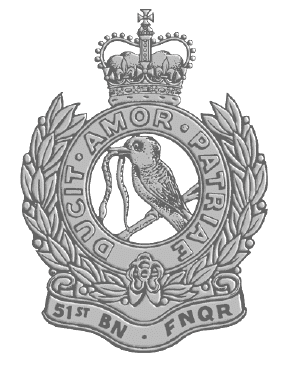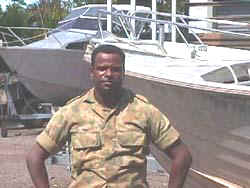 |
Note:
In this draft RFSU Trg Note continual reference is made to
Indigenous (Australian) peoples. This term is used to describe all
Aboriginal and Torres Strait Islander people regardless of
cultural location or specific clan/colloquial name. All other
people are described as non- Indigenous people.
Introduction
Indigenous people have had a
long association with the defence of modern Australia. There are
numerous examples of individual or small groups of Indigenous
people serving in this country's Defence Force since Federation.
During WW2 whole tribes or communities of adult male Indigenous
people where employed in both offensive and support roles across
the North of Australia. Some Indigenous people actually engaged
the Japanese while others perished in Japanese bombing raids. |

<<< One of our many
indigenous members
Regardless of early perceptions by
non-Indigenous people, the contribution made by Indigenous people was
both significant and reliable in the context of maintaining Australian
sovereignty.
Many so called Western cultures have
over time conducted warfare on foreign soil, where it was recognised
that the indigenous, or Aboriginal, people of that country could either
be used or supported to achieve their own aim. Most countries
acknowledge that to successfully conduct unconventional, special,
guerrilla warfare [(U/S/GW) raise, train and
develop para-military, mainly indigenous forces to conduct offensive
operations] requires the careful selection and training of personnel who
will ultimately interface with the indigenous people of the country
concerned.
(Example: T.E.Lawrence - Arab Forces, WW1).
Therefore, it is not surprising that
during WW2 Australia selected such people as W.E.H(Bill) Stanner, and
Donald Thomson, both Australian anthropologists with detailed experience
and knowledge in Indigenous culture, to raise and lead the 2/1 NAOU and
NTSRU respectively.* The Australian Coastwatcher organisation was also
led by expatriate Australians with years of experience, living and
working with the indigenous people of New Guinea, and the Solomon
Islands. * (Northern Australia Observer Unit - Northern Territory
Special Reconnaissance Unit) The RFSU Experience.
RFSUs were created in the early 1980s
with the aim of filling a gap in the ground surveillance capability of
Australia's Northern defence. Specifically, RFSUs were to utilise the
extensive local knowledge and skills that already existed among the
population of the North. It was recognised that to operate in this
austere environment would require knowledge and skills that the regular
forces would not readily possess.
A key feature of this concept was the
valuable contribution that Indigenous people would be able to make
again, as they did during WW2. Many Indigenous communities are located
on the front line and in areas where an Enemy may wish to lodge, and on
approaches to remote vital assets. For particular reasons, the Pilbara
Regt has been less active in the employment of Indigenous people. But
NORFORCE and 51FNQR boast high percentage of establishment Indigenous
representation: the former between 25-35%, and the later 45-58%. The
RFSUs have the highest Indigenous representation of any other ADF
organisation, and possibly any other Government agency (less ATSIC).
The Regional Force Surveillance List
(RFSL)
It is now well accepted that many
Indigenous people, and indeed non-Indigenous people living in remote
Australia, are not able to meet the strict criteria for enlistment and
service in the wider ADF. Literacy, numeracy and health standards
preclude many from this. However, to follow these standards rigorously
would deny the RFSUs access to a large portion of a sparse recruiting
base, effectively negating the original concept for creating RFSUs.
This was recognised as a key issue on
the formation of the RFSUs. It was overcome by the creation of the RFSL
(sometimes referred to as the special list). The primary document
providing policy for personnel and training issues for RFSUs, previously
AOSI 30/85 now DI-A Pers 173-8, details the conditions of the RFSL. This
document allows COs of RFSUs to enlist, appoint and promote, personnel
for employment as ECN304 Patrolman, or as part of a Local Observer
Element(LOE) network, while waiving specific enlistment criteria.
In many ways, the need to select and
train suitable personnel to interact with indigenous people, the concept
for creating the RFSUs, and the RFSL, well complement each other. It
stands to reason that the ability of COs to select and appoint local
non-Indigenous personnel who have experience with Indigenous people is a
strength of the RFSL.
However, in the case of the regular or
full time personnel posted to RFSUs, suitability and training to deal
with Indigenous circumstances, is not always a prerequisite. Many of the
general military standards and methods of training are not appropriate
when working with indigenous people. The way in which non-Indigenous,
mainly European, people relate to one another is quite foreign to
Indigenous people.
This training note has been developed
to outline the cultural diversity that exists within a RFSU. It should
be referred to as a guide for those non-Indigenous personnel who find
themselves interacting with Indigenous people, either in a unit liaison
role, or when directly leading and training Indigenous people in the
course of unit operations. The first meetings between people of
different cultures can often be awkward because of uncertainty about how
to behave. When you first meet Indigenous people you might find it
helpful to remember some of the information in this training note. In
time you will develop your knowledge and skills in communication.
from http://www.army.gov.au/51FNQR/index.htm |